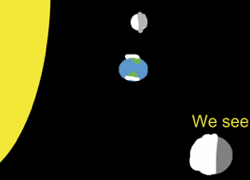This lesson is for : Grade 3:
Summary
The phases of the moon give us a beautiful calendar in the sky, but sometimes that calendar is difficult to read. Is the first quarter when the right or left side is lit up? Is the moon waxing or waning? Answering these questions takes a bit of perspective, and that’s why animation is an excellent way to broaden students’ understanding of these processes, especially if the students create the animation themselves. Third graders at Varina Elementary used ABCYa! Animate to create animated .gifs of four moon phases: (1) new moon, (2) first quarter, (3) full moon, and (4) last quarter (SOL3.8a). In order to be accurate, the students had to do some research. They had to find out which direction the moon orbits the Earth and what the moon looks like from Earth at different positions. Once they had their facts, they illustrated the position of the Sun, Earth, and moon for each phase, showing what we see from our perspective here on Earth. Next they exported the four images as one animated .gif file. Then they posted their animations to Google classroom with a question for their classmates to answer. After watching each other’s animations and answering each other’s questions, these third graders have a much clearer understanding of how the moon phases happen and the order in which they occur. Student samples: Layla Obey https://drive.google.com/file/d/0BykgMgzq4lmwaE81ZGp4bHNuWWc/view?usp=sharing Erin Harden https://drive.google.com/file/d/0BykgMgzq4lmwemVMQnVhSEcwVFE/view?usp=sharing
TIPC Ratings
Research & Information Fluency
Rating: Developing – Explanation: Students used teacher suggestions or their own choices for research. They applied their research to create an accurate animation of the moon’s phases. To rate higher, students could have generated their own questions for research, and they could have evaluated the accuracy of their resources.
Communication & Collaboration
Rating: Approaching – Explanation: Students were given the option to work in groups on the project. Their final animations were posted online for a wider audience. Students invited audience participation by asking a question about their animation for their viewers to answer. To rate higher, students could have consulted a space expert or an animation expert, and they could have reflected on their roles afterwards.
Critical Thinking & Problem Solving
Rating: Developing – Explanation: Students had to analyse the motions of the moon in order to create an accurate animation. They had to figure out the phase of the moon that corresponded to it’s position. To rate higher, students could have solved an authentic problem, chosen their own digital tools, and reflected on their roles afterwards.
Creativity & Innovation
Rating: Approaching – Explanation: Students created their own customized versions of moon animations. They were given artistic license to embellish their artwork as they wished. To rate higher, students could have gone beyond the assignment in creative new ways, and they could have set goals for future creative projects.




